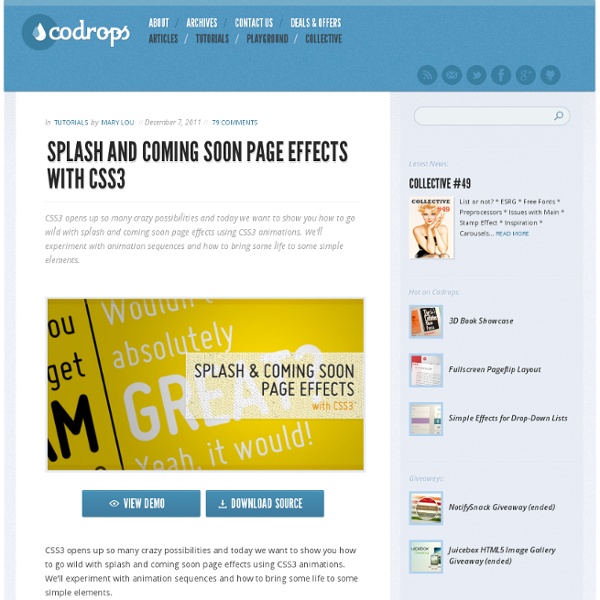Splash and Coming Soon Page Effects with CSS3

Animated Buttons with CSS3
Still hyped by the possibilities of CSS3, I want to share some CSS3 button experiments with you. The idea is to create some animated link elements with different styles, hover effects and active states. View demo Download source The icons used in some of the examples are by webiconset.com and the symbol font is by Just Be Nice We’ll go through every example and see how the HTML structure looks and what the styles for the normal, the hover and the active states are. Please note that the animations/transitions will only work in browsers that support those CSS3 properties. In order not to bloat the tutorial, I will not be using any CSS vendor prefixes. Example 1 In this example we will create a big button with several details in it. Markup The structure is pretty straightforward: the icon will be an image and the other elements will be spans: In the style we will make sure that the right transitions are set on the element that we want to animate on hover. Example 2 Example 3 Example 4 Example 5
Fix Inserted HTML5 Content with HTML5 innerShiv
When working with HTML5 today, many of you know that you'll need to include the "HTML5 shiv" to ensure that CSS will recognize and be able to style those elements in browsers that aren't yet hip to HTML5. Credit for that to Remy Sharp, Jon Neal, John Resig and anybody else who contributed to that idea. Also for the benefit of those non-hip browsers, it's best to reset many of the HTML5 elements to block-level as they should be: Now we're all set to use and style HTML5 elements. var s = document.createElement('div'); s.innerHTML = "<section>Hi! Or in jQuery: $("body").append("<section>Hi! Hip browsers do fine, but Internet Explorer will once again not recognize the new element and not apply CSS to it. Joe Bartlett has written a great work-around to the problem called HTML5 innerShiv and I thought more people should be aware of it. Update January 2013: This is now included in the canonical html5shiv project, you should use that. Using it Please note that this script does not require jQuery. 1.
Related:
Related:



